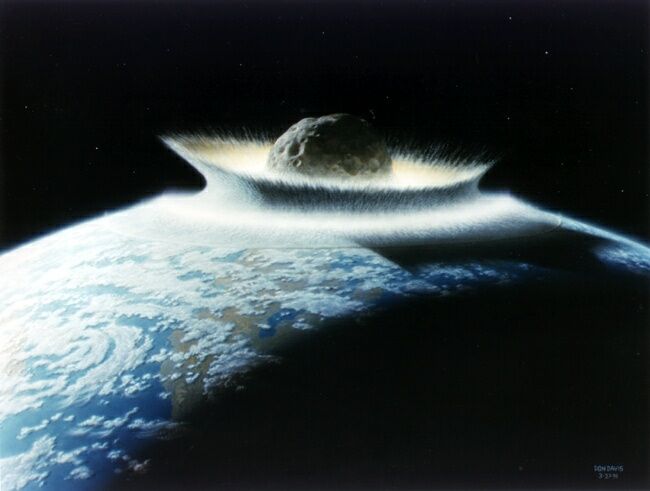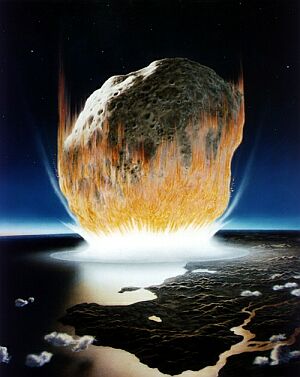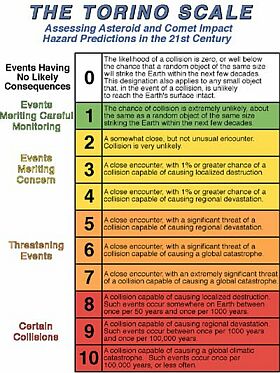It’s the End of the World As We Know It…

“(CNN) A sizable asteroid zipped near our planet this month without anyone noticing because it traveled through an astronomical blind spot, scientists said. The space boulder passed Earth within 288,000 miles on March 8, but since it came from the direction of the sun, scientists did not observe it until four days later. The object, slightly larger than one that flattened a vast expanse of Siberia in 1908, was one of the 10 closest known asteroids to approach Earth, astronomers said.”
Bit of a close thing, then – not really the sort of rock you want coming at a populated area, given that the one in Siberia, known as the Tunguska event, knocked down trees over a couple of thousand square miles. Though there’s actually some doubt over what that was – biological mutations and the lack of fragments have led some to speculate it was a UFO whose power plant blew up. Between that and Roswell, it’s quite reassuring to discover that ET’s can’t drive either.

Whatever it was, it landed in about the best place possible, from our point of view. Had it come down in water, as the odds favour, a tidal wave would have been the likely result. Had it hit Western Europe, one estimate puts the death toll at half a million. Instead, the main impact was an entry in the Guinness Book of Records, under “World’s Largest All-you-can-eat Barbecued Reindeer Buffet”.
Back in the present day, I find it interesting that news of the near approach was relegated to a minor report (no mention at all on the BBC web site, for example), after the fact. For it strikes me that, if any extinction-level event were ever in the offing, the general public would be the last people to know. Even NASA admits this: “The most likely warning today would be zero,” says their FAQ on the topic.
The mathematics involved don’t help. If we don’t know precisely – and I mean, precisely – how much an object weighs, we can’t tell how its path will be affected by other bodies in the solar system. A tiny error of just one-hundredth of one degree, over thirty million miles (a relatively small distance in astronomical terms), ends up more than 5000 miles out. Quite enough to make the aforementioned “bit of a close thing” become “straight between the eyes”.
But even if an amateur astronomer was to discover something barreling in this general direction, the people with the knowledge and computing power to work out whether or not it would hit the Earth are few and far between – it’s not something your average citizen could work out on a beer-mat. Such academics are also likely to be heavily reliant on government funding, and so probably would be amenable to pressure. Would any of them be prepared to go public?

The past history of such things, and human nature in general, combine to make me pessimistic. The last thing governments want is widespread panic, so I suspect any warning would be self-generated, extremely brief, and go something along the lines of, “What’s tha…”. It is ‘comforting’ to discover that we now have the Torino scale, which reduces the complex nature of all such threats to a number from 0 to 10. I firmly expect the needle to remain rooted at zero, right up until the North American continent becomes a smoking crater. We’ll then hear the line familiar to all bikers: “Sorry, mate, I didn’t see you!”.
Though actually, I can see the point of keeping it quiet; telling the general population wouldn’t help much, and would probably just cause a lot of senseless milling-around. There’s no way to tell exactly where any impact would occur – the wildly inaccurate stabs made whenever satellites come down tell us that much – and the old Protect and Survive saw about no place being safer than any other actually rings partly true, especially given the possibility of tidal-waves if it lands in the water. Better for the powers that be to get on quietly with firing Bruce Willis into space – an idea so appealing it might be worth faking it, merely to prevent any possibility of Hudson Hawk 2.
A couple of final thoughts – as Jerry Springer might say, if he were to host a show entitled When Near-Earth Objects Attack. In the process of researching this piece, I found a link to a document called “The Probability of Collisions With Earth” at Los Alamos National Laboratory. I note, with some alarm, that the file in question now needs a username and password to access it. I’m sure this is just a coincidence – nothing to worry about. And astronomer Duncan Steel has estimated that a rock of about 50 metres in size – big enough to wipe out New Jersey (not necessarily a bad thing, I grant you) – can be expected to hit Earth about once every 100 years. It’s been 94 years since Tunguska. Pleasant dreams.